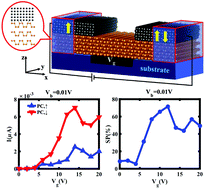Gate-tunable large spin polarization in a few-layer black phosphorus-based spintronic device†
Abstract
We report a first principles study of the gate tunable spin transport properties in trilayer black phosphorus (BP) placed on a Ni(100) electrode. In the proposed spintronic device, the spin-dependent conductance and the corresponding spin polarization can be largely modulated by the gate voltage. Instead of resorting to the gate tunable spin orbital interaction (SOI) mechanism in the traditional spintronic devices, the control scheme here is achieved by the giant Stark effect induced semiconducting-metallic phase transition of the few-layer BP. It is found that the quantum tunneling effect is gradually reduced as the gate voltage increases. During this process, the conductances of spin up and spin down components increase differently and hence the spin polarization is largely varied from 7% to 77% in parallel configuration (PC) and from 1% to 54% in anti-parallel configuration (APC). More importantly, the maximum magnetoresistance (MR) value can reach as large as 80%. Finally, we find that the non-equilibrium spin-polarized current can also be controlled by the external bias voltage. For instance, a large turn on/off ratio can be realized by the gate voltage (4239 for spin down current and 1809 for spin up current) when the bias voltage is fixed at 0.01 V. Our theoretical findings pave a feasible way for the novel application of few-layer BP in spintronic nanodevices.



 Please wait while we load your content...
Please wait while we load your content...